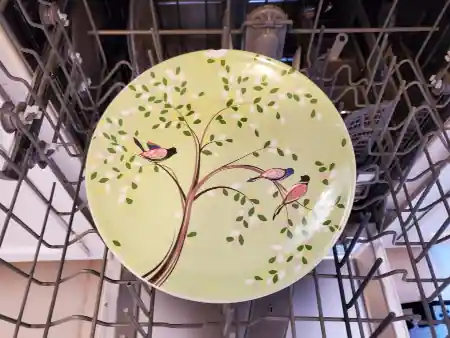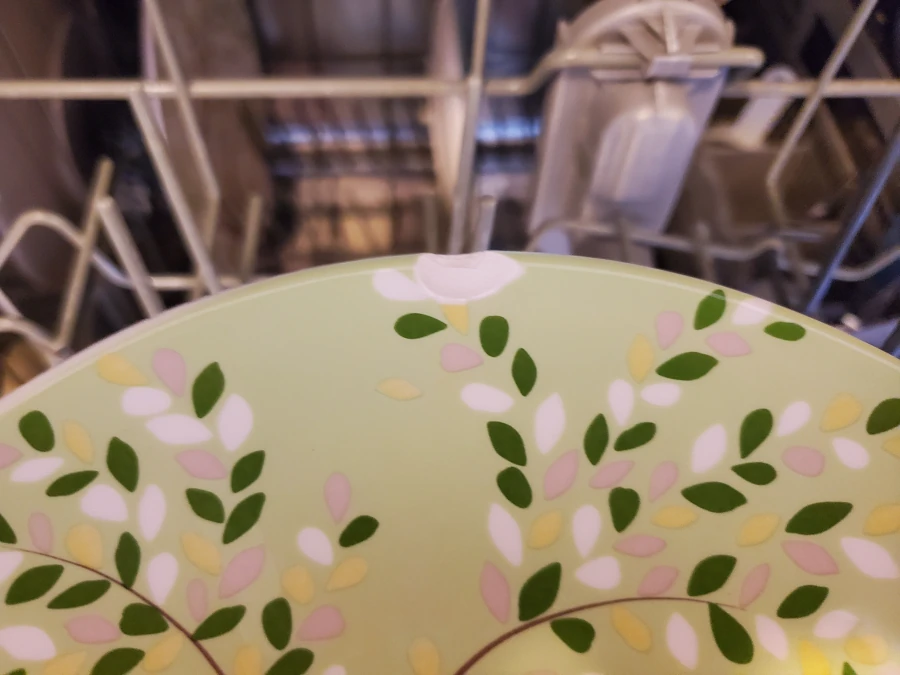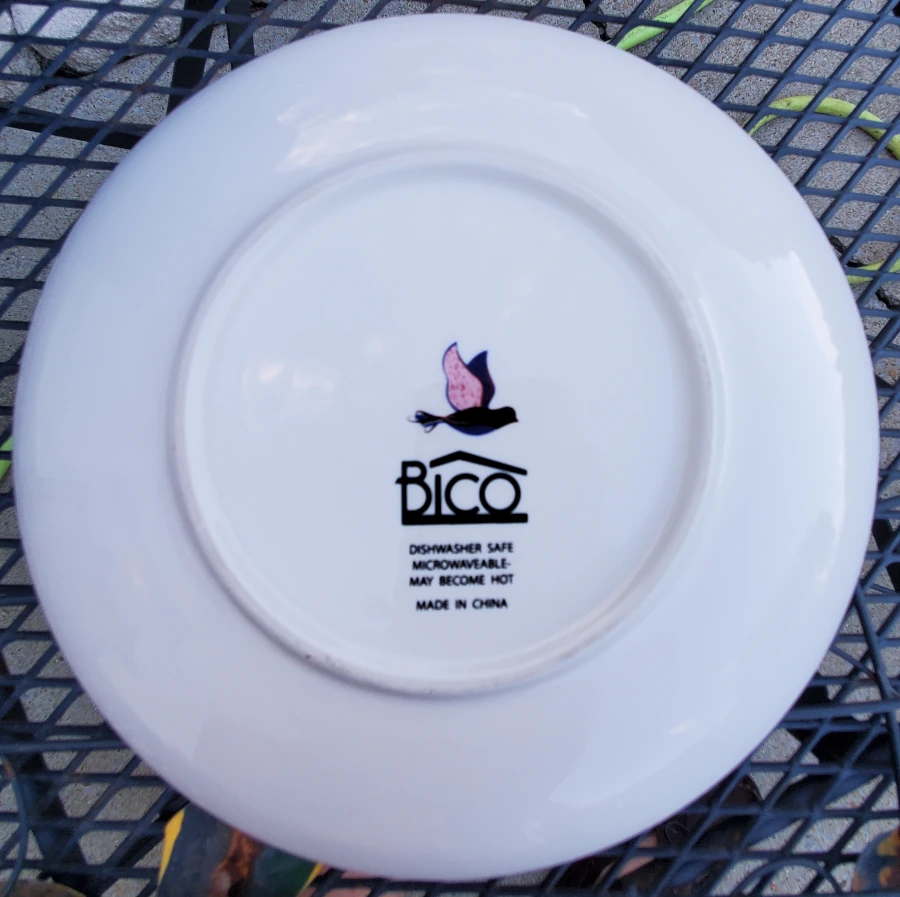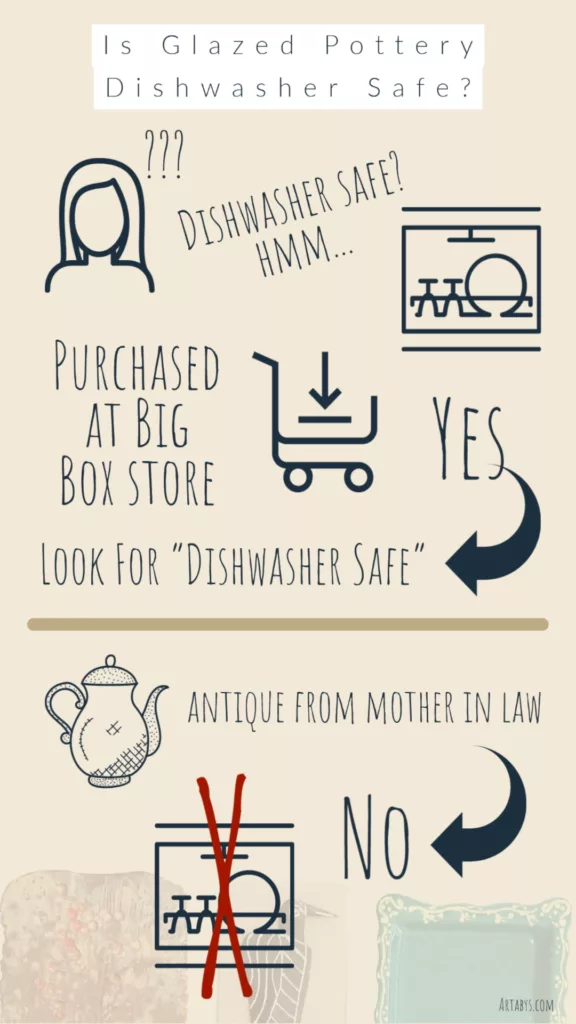Is Glazed Pottery Safe to Wash in the Dishwasher?
Glazed pottery may be washed in the dishwasher. Glazed pottery after everyday usage in the dishwasher retains gloss, and colors remain vibrant. Even glazed pottery in matte glazes does not wear out in the dishwasher. Glazed pottery is tough, long-lasting, and dishwasher safe. Avoid drastic fluctuations in temperature and bumping pottery into each other while in the dishwasher for safety.
Now all that being said, I do not wash any pottery I care about in the dishwasher.
Dishwasher Safe Pottery Glazes
Ceramic glazes when fired to the proper temperature are practically indestructible. Mid-range glazes for use with cone 5/6 fired are dishwasher safe. One of my favorite glazes is from Mayco. I can find Mayco Stoneware Glazes in a wide range of hues, textures, and opaque features. Stoneware glazes are gloss, matte, ice, opal, linen, and crystals. And for even more color variety, you can optionally add a light or dark flux. I like Mayco because of its wide firing glazing range and is compatible with stoneware. Stoneware is a non-porous ceramic tableware manufactured from stoneware clay that has been fired at temperatures ranging from 2150 to 2330 degrees Fahrenheit. As a general rule of thumb I always avoid soaking any of my stoneware dinnerware for extended periods of time just to be on the safe side.
If the pottery or dish is unglazed when washed the pottery will absorb water. If you have unglazed pottery or dinnerware you should always remember to steer clear of detergent. You should avoid soaking pottery in water. This is why you see so many terracotta pots crack in the winter time. they are left outside and absorb moisture (water drops from rain for example) and then it gets cold and the pot freezes. The moisture absorbed inside the pot then expands thus cracking the pottery.

All properly fired glazes are absolutely dishwasher safe. However, there is the possibility that you have pottery that was fired incorrectly. Glazes fired incorrectly (not at the right temperature) will not be as durable and, as a result, will break down over time after being washed in the dishwasher. In addition, you may see signs of wear not related to being used in the dishwasher. This is because someone did not correctly fire the glaze.
Porcelain and high fire clay tend to do better in the dishwasher. Porcelain is a white porcelain that is transparent and incredibly durable. It is made by combining finely powdered glass, granite, and feldspar elements with water until the combination is malleable. The final pieces are fired between 1200°C and 1450°C before being glaze-coated and fired again.
The biggest factor for me is making sure the dishwasher is packed carefully. Ceramic dinnerware when loaded into the dishwasher must be carefully packed so that when the dishwasher is running ceramic ware is not banging around. Otherwise you could end up with a bunch of ceramic pieces. And what about kitchen-specific glass or glass, can they go in the dishwasher? Well, sort of. And I say sort of because If I care about it it does not go in the dishwasher. Dishwasher-safe wine glasses and durable drinking glasses are good, but fragile glassware, hand-blown or hand painted glass, and crystal should be washed by hand to avoid breakage, yellowing, or etching caused by harsh detergent, which shows as cloudiness or pitting.
Dishware Food Safety
The FDA has conducted tests (extensively tested) to classify pottery dishware as food safe. I only use food safe and dishwasher safe glaze on all my artwork. Even if my artwork is made to hang on the wall it does not matter. I still use only food safe glazes. But there are glazes out there that are not food safe.
To classify clay dishware as food safe, the FDA carries leach testing. Reducing leaching or eliminate leaching of any kind is always a good idea. Even if the glazed contains lead or cadmium prior to fire, it can still be labeled as food safe if it fulfills FDA criteria.
Here is an explanation of what glazes do and how they may interact with food if not using food safe dishwasher safe glazes.
Traditional pottery and other kinds of ceramic ware are formed of earthenware, a porous form of clay that must be glazed in order to contain food or liquid. Glazing is the process of applying and fusing a thin, glass-like layer to the surface of the clay in order to close its pores.
When fired in a kiln, the glaze, may contain lead to aid the melting of glaze particles (added to make make glazes flow better at low temperatures), fuses to the pottery. When the pottery is fired at the correct temperature for the appropriate period of time, the lead is virtually bonded into the glaze. If some transfers to food, it will be a negligible amount. However, if the pottery is not properly fired, the lead may not fuse to the earthenware and may contaminate food if it is used with food thus cause lead poisoning and proven toxic. Two materials that are proven toxic are lead and cadmium.
Many potters of traditional or “folk” pottery have shifted to non-lead glazes, but they may still be utilizing ancient kilns that were originally used to fire lead-containing glazes, unwittingly contaminating the “lead free” pottery with lead residues that linger in the kiln from previous use. I have never fired a lead glaze in my electric kiln. Therefore my kiln has never been contaminated with glazes containing lead.
Also it’s important to note because lead may not fuse with the non-lead glaze, however, when the pottery is used with food, it may contaminate it. Also it important to look out for acid resistant glazes. These glazes have been tested with food to ensure safety but are not always suitable for certain foods. So although lead free glazes are safe not all have been tested with acid foods (acidic food) like lemon juice. So just because a glaze is lead free does not mean it can also resit certain types of high acid foods.
Dishwasher Safe Plates And Pottery

I have found based on my experience is that potter glazes hold up well, but the stoneware itself does not. The stoneware tends to chip in the dishwasher due to improperly stacking plates or cups where they can accidentally bang against each other. I have some Spode Christmas plates, for example, that I will never put into the dishwasher because of this.
How different are Clay and Terracotta? The clay is an ingredient, but terracotta is a molded and fired clay. Terracotta articles are typically made of biological clay, although terracotta clay is connected with the word with the color. Low-temperature burning of terracotta materials provides a porous and permeable surface.
What is Raku Firing Technique? – Raku firing is a type of low-temperature firing. Volatile parts of compounds and molecules in the clay/glaze break away during a Raku firing, and the free oxygen clings to the remaining material. Oxides are formed as a result of this. This is referred to as oxidation. The oxidation modifies the glaze’s color as well as the texture of your clay. The changes might be rather profound at times.
I have some cheaper stoneware plates and pottery (stoneware dinnerware) I am not afraid to load into the dishwasher because if they chip over time, I’ll just purchase more. After all these are not ornate pieces like what you would use only on special occasions. For pottery I care about, it’s gets hand-washed. Stoneware dishes are typically made from Kaolinite in which gives them their strength. Stoneware has a low melting point as compared to porcelain.
Items NOT Dishwasher Safe
- Wooden items like utensils and cutting boards
- Fine china, china, bone china you really care about
- Insulated mugs and mugs that are insulated and look like a cup or glass
- Any kind of copper cookware pans
- Cast iron pans
- Fine crystal
Items Dishwasher Safe
- Pyrex measuring cups, bowls and mugs and drinking glasses
- Metal and Silicone utensils
- Ceramic plates, bowls, cups and mugs
- Hard plastic measuring spoons and cups
- Tableware made of stainless steel like spoons, forks and butter knives
As always it’s a good idea to check the manufacture labels for dishwasher safe labels. As you and I know sometimes what appears to be dishwasher safe is not always the case.
How Can I Tell If My Ceramic Dish Is Dishwasher Safe?

One really easy way to tell if your bowl or plate is dishwasher safe (Pottery Microwave Safe or Ceramic Microwave Safe) is to take a quick look at the bottom of the bowel or plate. If there is no glaze on the bottom then its definitely not dishwasher safe. If a clay pot or ceramic is microwave safe is going to depend on how much metal is used in the ceramic or dinnerware. If the ceramic plate has metal decorations or if a metal based paint was used for decorations then it’s not going to be microwave safe. I see this on some earthenware dishes or earthenware dinner ware. Theses are hand wash only.
If handmade ceramics are fired properly, they are dishwasher safe. If not, then you will notice the glaze start to lose its gloss. Most ceramics will say on the back if they are dishwasher safe.
I create both ceramic plates and sculptures and all of my artwork is fired correctly and I only use glazes that are durable and are wear resistant. I have been using my pottery for decades with no problems of glaze wearing out.
Some ceramics are created for decorative use only. These are antiques and made specifically for decoration. If you know the history of your pottery, it will help you decide on how you want to care for it. You made decide to error on the side of caution and wash antiques by hand. Other pottery where you know the manufacture and are willing to take more chances on the dishwasher may be the way to go.
Is It Safe To Wash Glazed Pottery In The Dishwasher?
When placed in the dishwasher, most glazed pottery will not have any issues. You might also look for a sign with water droplets on a glass or plate beneath the Pottery. This means you may safely put it in the dishwasher.
Dishwashers are safe to use on glazed ceramics. Glazed pottery keeps its shine and color vibrancy after regular dishwasher use. Even matte-glazed pottery does not deteriorate in the dishwasher. Glazed pottery is durable, dishwasher-safe, and long-lasting. To keep your dishes safe, avoid extreme temperature changes and knocking them into each other while they’re in the dishwasher.

Glazed pottery is tough, long-lasting, and dishwasher safe. Avoid drastic fluctuations in temperature (sudden changes) and bumping pottery (sudden shocks) into each other while in the dishwasher. When glazed pottery goes from a low temperature, to room temperature to high temperatures or in reverse order, they tend to crack or wear prematurely. I always like to open the dishwasher door and let the pottery cool down a bit so that it not going trough a drastic temperature change. Glaze keeps its gloss, and colors remain vibrant after washing. Even glazed pottery in matte glazes does not wear out in the Dishwasher.
Avoiding drastic temperature changes also includes ovens. to avoid breaking do not transfer ceramic dishware directly from the freezer to a hot oven. Even if my plate says its oven safe I avoid doing this because of the drastic change (sudden shock) in temperate and the likely possibility my plate will break. this is something you do not have to worry about when using stainless steel or cast iron. They are able to handle the thermal shock a lot better.
Also using very hot water and also using a very strong dish washing detergent, or using too much detergent can also affect certain pottery glazes. Do this on a consistent bases could prematurely wear out certain glazes.
But chipping is another story. Pottery put into the dishwasher is likely to get chipped as it gets banged into each other.
My number one rule is if you care about it then don’t put it in the dishwasher. I say this because of my own experience of having really nice kiln fired ceramic plates last longer by not putting them (bone china or fine china) in the dishwasher.
References
Gould, J. H., Hight, S. C., Alvarez, G. H., Nelson, C. E., & Capar, S. G. (1990). Influence of automatic dishwashings and scrubbings on release of lead from glazed ceramicware. Journal of the Association of Official Analytical Chemists, 73(3), 401-404. https://academic.oup.com/jaoac/article-abstract/73/3/401/5691839
Wallace, D. M., Kalman, D. A., & Bird, T. D. (1985). Hazardous lead release from glazed dinnerware: A cautionary note. Science of the total environment, 44(3), 289-292. sciencedirect.com/science/article/abs/pii/0048969785901019
Beveridge, E. (1950). Tools for food preparation and dishwashing. Bureau of Human Nutrition and Home Economics. https://books.google.com/books?hl=en&lr=&id=5OOgpTynJh4C&oi=fnd&pg=PA30&dq=Glazed+Pottery+Dishwasher+Safe&ots=BsNSn_FFuJ&sig=2tW9DZM_hH4hvbPVPNus1YxwG5I#v=onepage&q&f=false





